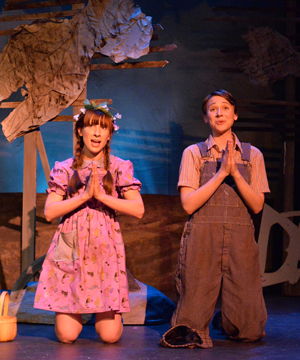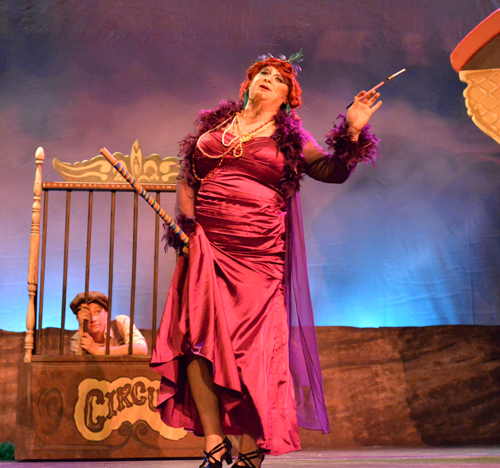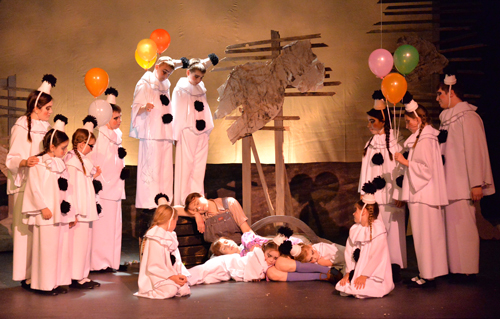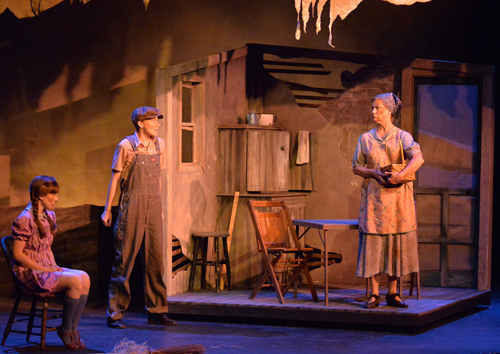by Daniel Hathaway
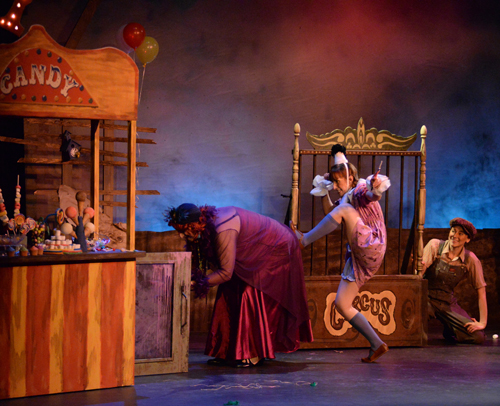
It was talented student casts who turned the tables on the sorceress in those previous performances. Nightingale, a company of professional singers, brought an especially high level of vocal prowess and acting experience to Humperdinck’s retelling of the famous fairy tale, while retaining the feel of a community production by casting young human beings as children and angels. Fenlon Lamb’s efficient staging and John Simmons’s expert musical direction worked equally well for professionals and young actors.
Katie Fowler, perfectly channeling a gangling teenager, was splendid as Hansel. Melissa Davis made a charming, ever-so-slightly-mischievous Gretel. Their clear, attractive voices carried well into the 200-seat auditorium and blended beautifully in their duets.
Marla Berg was fearsome in bearing and strong of voice as Gertrude, the nagging mother. Brian Johnson made a fine impression as Peter, the father, singing with a rich, even tone and projecting his buoyant personality to all corners of the stage.
With the appearance of Lara Troyer in the first of her roles, the Sandman, the production left the world of the Brothers Grimm and entered its campy stage. Mustachioed and costumed like a ringmaster (or was it a British horsewomen ready to ride to the hounds?), she gave a hint of the fun to come. Berg returned at dawn as the Dew Fairy, this time outrageously got up like a showgirl fresh from a late night in Vegas.
That of course led to the first sighting of The Witch, aka Rosina Daintymouth, a drag role hilariously played and uproariously sung by Tim Culver, who looked remarkably like the Minister of Morality trying to escape from La Cage aux Folles (French version). More sinister than your standard-issue witch, Culver conjured up especially dark images when he drew lollipops out of his capacious bosom.
Continuing a wacky costuming trend, the fourteen members of the children’s chorus who appeared as angels to guard the sleeping children wore Pierrot-style clown suits and bore balloons.
This production was set — somewhat mysteriously — in the American Dust Bowl of the 1930s, but it’s difficult for Hansel and Gretel to shed its nineteenth century German flavor. (Example: Hansel and Gretel go out searching for strawberries in a deserted town, but they sing about being in the forest). Putting that cognitive dissonance aside, the stage sets were attractive and evocative even in their simplicity. A goofy crew of heavies in patched clothing pushed the sets around between scenes.
Behind the scenes, connected only by audio and video, Steve Eva’s Chagrin Studio Orchestra provided colorful, somewhat muffled but mostly well-coordinated instrumental accompaniment for the production. It was wise to have cut most of the lengthy overture.
Having seen two Hansel and Gretel productions already this season, I wasn’t sure I was especially looking forward to a third. But it’s fascinating to see what different ideas directors and companies can bring to this familiar opera, and Nightingale Opera Theatre’s take was fresh and alluring from curtain to curtain. The final scene was particularly affecting this time around.
Photos: Michael’s Portrait Design.
Published on ClevelandClassical.com July 1, 2014.
Click here for a printable copy of this article.




